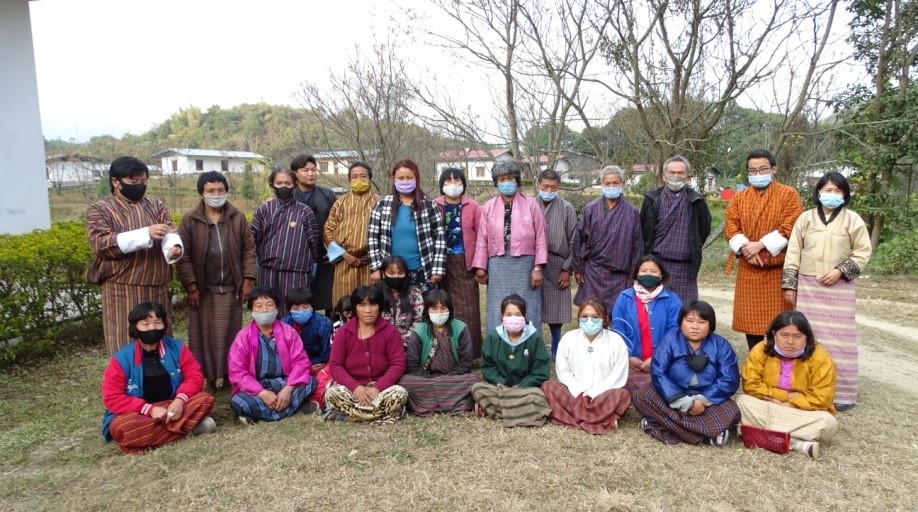![]()
Bhutan is rich in biodiversity and so in terms of crop diversity. Crop diversity is a component of agro-biodiversity which is a subset of biodiversity. Crop diversity is the foundation of agriculture, enabling it to evolve and adapt to meet the never-ending challenge of sustainably producing sufficient and nutritious food for an increasing population. Crop diversity is a key to seed, food and nutrition (SFN) security and is a prerequisite for sustainable agriculture. Crop diversity translates to nutritional diversity and therefore the dietary diversity that contributes to the good health of the population. Crop diversity is the reservoir of diverse genes for current and future crop breeding and varietal development to meet the changing needs of the nation. Crop diversity is one of the mechanisms for climate change adaptation. Crop diversity is intricately linked to Bhutanese traditions and culture. There are many crops and their varieties that are packed with numerous vitamins and minerals some of which are not even discovered by scientific research.

Apparently, despite tremendous benefits to humanity rendered by the natural biological wealth, the prevalence of genetic erosion of many crops and varieties are on the rise in Bhutan.
Therefore National Biodiversity Centre in collaboration with Gewog Agriculture Sector of Gongdue Gewog, Mongar Dzongkhag conducted Crop Diversity Inventory on the 12th January 2022 at Gongdue Gewog, Mongar Dzongkhag.
The Crop Diversity Inventory was conducted with the following objectives:
- To create education and awareness among the farming communities on the importance of crop diversity
- To assess the extent of crop diversity existing in the farmers’ field.
- To identify crops and varieties and the donor farmer for germplasm collection.
The meeting was attended by 20 farmers consisting of 4 male and 16 female farmers representing different Chiwogs including Agriculture Extension Officer, Gondue Gewog.
- Introduction to biodiversity, agro-biodiversity, and crop diversity:
The farmer participants were first introduced to the concept of biodiversity, agro-biodiversity and then narrowed down to crop biodiversity. Then the farmer participants were presented with the various rationales for the importance of crop diversity. Farmers were also informed of the trend and various developments in the global arena when it comes to crop diversity. Participants were also informed of the various efforts being put in place by the government in securing diversity in the gene bank and also maintaining on-farm diversity.
- Inventory of crop diversity being cultivated in Gongdue Gewog:
Education and awareness was followed by inventorying of crop and varietal diversity being cultivated by the farmers of Gongdue Gewog.
 The on-farm crop diversity inventory revealed the existence of a total of 60 crops consisting of about 120 crop varieties viz cardamom, maize, rice, foxtail millet, finger millet, bitter buckwheat, sweet buckwheat, barley, little millet, mustard, perilla, amaranth, quinoa, sorghum, groundnut, beans, lablab beans, cowpea, azuki bean, soybean, peas, black, gram, potato, sweet potato, tapioca, yam, colocasia, orange, peach, plum, pineapple, avocado, litchi, mango, pear, banana, guava, areca nut, papaya, pomegranate, passion fruit, sugarcane, chayote, pumpkin, cucumber, chili, brinjal, tree tomato, carrot, reddish, spinach, mustard green, cauliflower, cabbage, broccoli, coriander, garlic, onion, ginger, turmeric, stuffing cucumber or slipper gourd, etc.
The on-farm crop diversity inventory revealed the existence of a total of 60 crops consisting of about 120 crop varieties viz cardamom, maize, rice, foxtail millet, finger millet, bitter buckwheat, sweet buckwheat, barley, little millet, mustard, perilla, amaranth, quinoa, sorghum, groundnut, beans, lablab beans, cowpea, azuki bean, soybean, peas, black, gram, potato, sweet potato, tapioca, yam, colocasia, orange, peach, plum, pineapple, avocado, litchi, mango, pear, banana, guava, areca nut, papaya, pomegranate, passion fruit, sugarcane, chayote, pumpkin, cucumber, chili, brinjal, tree tomato, carrot, reddish, spinach, mustard green, cauliflower, cabbage, broccoli, coriander, garlic, onion, ginger, turmeric, stuffing cucumber or slipper gourd, etc.
The inventory also revealed that approximately 10% of crop diversity existing in Gongdue Gewog are improved or imported varieties whereas 90% consisted of local/traditional crops and crop varieties.
Gondue Gewog exhibited very high levels of crops and varietal diversity. Total of 47 varieties showed an increase in the cultivation trend and 43 varieties showed stable in cultivation trend. Unfortunately, a very high number of 30 crops varieties showed a decrease in cultivation trend, and 8 crop varieties were reported to have been lost. There are numerous reasons for the decline in cultivation trend or loss of certain crops which have been documented.
The on-farm crop diversity inventory information will be used subsequently to build National on-farm Crop Diversity Database.
- Germplasm collection
After enlisting the crop diversity being cultivated in Gongdue Gewog, donor farmers/custodian farmers were identified for different crops for which the seeds are currently available. The germplasm collection is on-going for the selected crops and crop varieties from those identified donor farmers/custodian farmers during the inventory.



